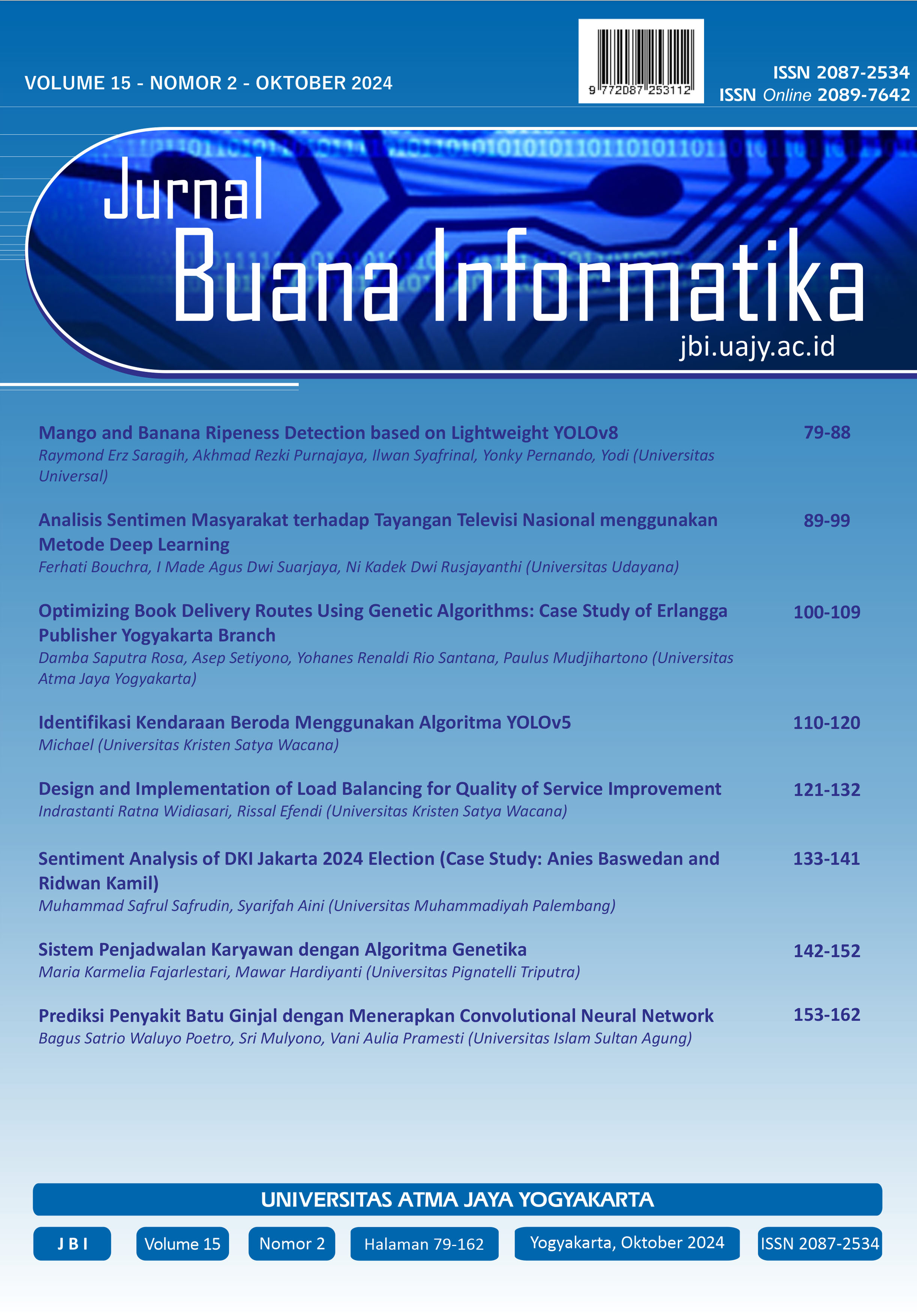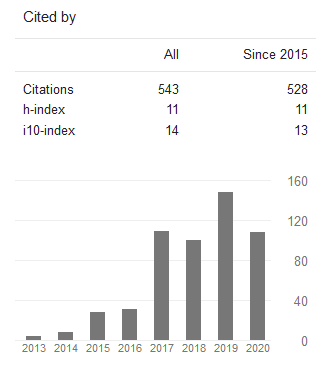Analisis Sentimen Masyarakat terhadap Tayangan Televisi Nasional menggunakan Metode Deep Learning
Keywords:
national television, sentiment analysis, Twitter, deep learning, Bi-LSTM, televisi nasional, analisis sentimenAbstract
Indonesia’s television industry faces fierce competition, particularly in chasing ratings and ad revenue. This has ultimately led to declining broadcast quality on some national TV stations. This research aims to understand perceptions towards content quality by focusing on public opinion through sentiment analysis of social media (Twitter) using Bi-LSTM and Word2Vec methods. The research involved data collection, preprocessing, vectorization, data splitting, model training and testing, evaluation to find the best model, sentiment data classification, and finally, sentiment data analysis. Using a dataset of 515,492 sentiment points, the model achieved an accuracy of 96.4%, precision of 72.1%, recall of 72.0%, and f1-score of 72.8%. Analysis of Twitter user sentiment leans towards neutral and positive perceptions. The results of the sentiment analysis of Twitter users tend to be neutral and positive. The results of the public satisfaction trend show a change in the pattern of public satisfaction with the quality of television station content.
References
A. Abdullah and L. Puspitasari, “Media Televisi Di Era Internet,” ProTVF, vol. 2, no. 1, p. 101, 2018, doi: 10.24198/ptvf.v2i1.19880.
R. S. M. Permana and J. N. Mahameruaji, “Strategi Pemanfaatan Media Baru Net. TV,” Jurnal Studi Komunikasi dan Media, vol. 23, no. 1, p. 21, 2019, doi: 10.31445/jskm.2019.1770.
F. Junaedi, Rating Naik, Etika Hilang, 1st ed., Yogyakarta, Indonesia: Buku Litera, 2022.
N. H. Hamzah, E. F. F. Khomaeny, and M. Ulfa, “Tontonan Anak di Televisi: Paradoks dan Kontestasi Nilai Tontonan Anak di Media Televisi Nasional,” Jurnal Obsesi: Jurnal Pendidikan Anak Usia Dini, vol. 5, no. 2, pp. 1883–1893, 2021, doi: 10.31004/obsesi.v5i2.713.
Samsir, Ambiyar, U. Verawardina, F. Edi, and R. Watrianthos, “Analisis Sentimen Pembelajaran Daring pada Twitter di Masa Pandemi COVID-19 Menggunakan Metode Naïve Bayes,” Jurnal Media Informasi Budidarma, vol. 5, no. 1, p. 149, 2021, doi: 10.30865/mib.v5i1.2604.
D. R. Alghifari, M. Edi, and L. Firmansyah, “Implementasi Bidirectional LSTM untuk Analisis Sentimen Terhadap Layanan Grab Indonesia,” Jurnal Manajemen Informatika, vol. 12, no.2, pp. 89–99, Sep. 2022, doi: 10.34010/jamika.v12i2.7764.
H. F. Fadli and A. F. Hidayatullah, “Identifikasi Cyberbullying pada Media Sosial Twitter Menggunakan Metode Klasifikasi Random Forest,” Automata, 2019. [Online]. Available: https://journal.uii.ac.id/AUTOMATA/article/download/17364/10897
A. K. Ni Komang, I. M. A. D. Suarjaya, and I. M. S. Raharja, “Classification of Public Figures Sentiment on Twitter Using Big Data Technology,” Jurnal Informatika dan Telekomunikasi Teknik, vol. 6, no. 1, pp. 157–169, 2022, doi: 10.31289/jite.v6i1.7329.
G. A. M. Kukuh Jaluwana, G. M. A. Sasmita, and I. M. A. D. Suarjaya, “Analysis of Public Sentiment Towards Government Efforts to Break the Chain of Covid-19 Transmission in Indonesia Using CNN and Bidirectional LSTM,” Jurnal RESTI: Rekayasa Sistem dan Teknologi Informasi, vol. 6, no. 4, pp. 511–520, 2022, doi: 10.29207/resti.v6i4.4055.
W. Widayat, “Analisis Sentimen Movie Review Menggunakan Word2Vec dan Metode LSTM Deep Learning,” Jurnal Media Informasi Budidarma, vol. 5, no. 3, p. 1018, 2021, doi: 10.30865/mib.v5i3.3111.
A. F. Hanif, T. B. Sasongko, and A. D. Laksito, “Perbandingan Kinerja LSTM, Bi-LSTM, dan GRU pada Klasifikasi Judul Berita Clickbait,” Indonesian Journal of Computer Science, vol. 12, no. 4, p. 2136, 2023.
W. K. Sari, D. P. Rini, R. F. Malik, and I. S. B. Azhar, “Multilabel Text Classification in News Articles Using Long-Term Memory with Word2Vec,” Jurnal RESTI: Rekayasa Sistem dan Teknologi Informasi, vol. 4, no. 2, pp. 276–285, 2020, doi: 10.29207/resti.v4i2.1655.
D. I. Af’idah, D. Dairoh, S. F. Handayani, R. W. Pratiwi, and S. I. Sari, “Sentimen Ulasan Destinasi Wisata Pulau Bali Menggunakan Bidirectional Long Short Term Memory,” Matrik: Jurnal Manajemen, Teknik Informatika dan Rekayasa Komputer, vol. 21, no. 3, pp. 607–618, 2022, doi: 10.30812/matrik.v21i3.1402.
D. I. Puteri, “Implementasi Long Short Term Memory (LSTM) dan Bidirectional Long Short Term Memory (BiLSTM) dalam Prediksi Harga Saham Syariah,” Euler: Jurnal Ilmiah Matematika, Sains dan Teknologi, vol. 11, no. 1, pp. 35–43, 2023, doi: 10.34312/euler.v11i1.19791.
M. D. Rahman, A. Djunaidy, and F. Mahananto, “Penerapan Weighted Word Embedding pada Pengklasifikasian Teks Berbasis Recurrent Neural Network untuk Layanan Pengaduan Perusahaan Transportasi,” Jurnal Sains dan Seni ITS, vol. 10, no. 1, 2021, doi: 10.12962/j23373520.v10i1.56145.
Downloads
Published
Issue
Section
License

This work is licensed under a Creative Commons Attribution-ShareAlike 4.0 International License.
Copyright of this journal is assigned to Jurnal Buana Informatika as the journal publisher by the knowledge of author, whilst the moral right of the publication belongs to author. Every printed and electronic publications are open access for educational purposes, research, and library. The editorial board is not responsible for copyright violation to the other than them aims mentioned before. The reproduction of any part of this journal (printed or online) will be allowed only with a written permission from Jurnal Buana Informatika.
This work is licensed under a Creative Commons Attribution-ShareAlike 4.0 International License.










